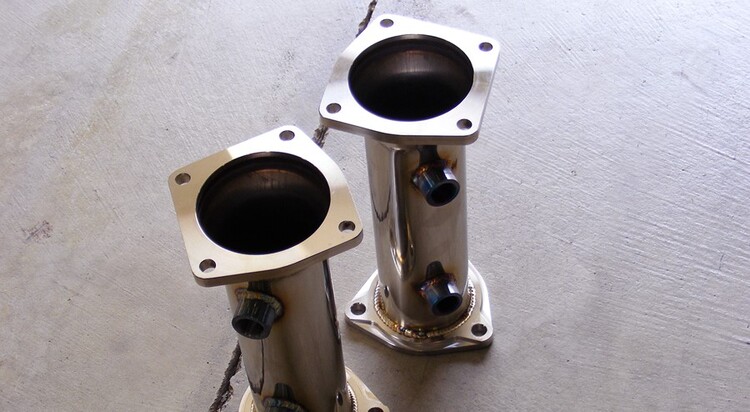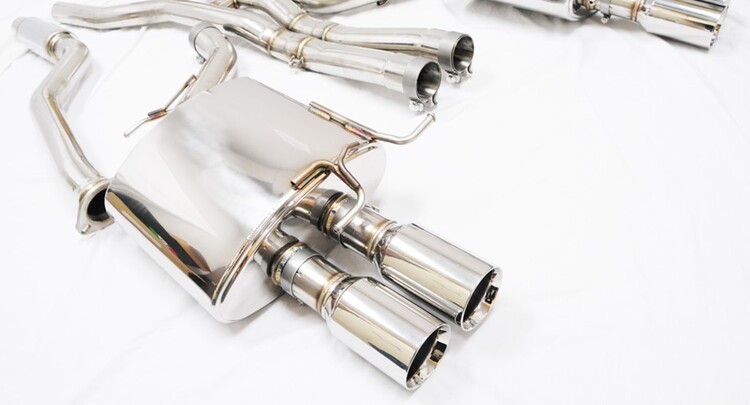What Are Test Pipes, And How Do They Work?
A free-flowing exhaust is just as crucial as an unrestricted air intake for your engine to operate at its best – this is where test pipes prove their worth.

Jump To Section
Introduction
Airflow is everything. Talk to any engineer and he or she will tell you that getting air in and out of an engine is always a big problem.
What we mean to say is, you can just replace fuel injectors and spark plugs for bigger counterparts, and there you have it – two of the three things responsible for combustion are now optimized. But what about the third – air?
For that, you have to dive deep into the world of pipes. The more unrestricted your intake is the more smoothly you can get air in, and the more unrestricted your exhaust is; the smoother air exits the engine. Read our example on different air intakes for your 350z, to understand this better.
Keep in mind that engines are spinning at thousands of RPMs. Exhaust gases are being produced at the same rate, and for this, engines need a good exhaust route as much as they need fuel and air.
What Are Test Pipes

If you’re looking for unbridled horsepower, modifying your standard exhaust system might be a good option. This is where test pipes come in. A test pipe is just a straight pipe that replaces your catalytic converter.
Test pipes are also often used for both race and off-road use, mainly because temperatures in both of these setups exceed regular values, and thus, a test pipe is preferred.
The catalytic converter has a honeycomb mesh inside it that causes a big hindrance in the exhaust flow. Replace it with a straight pipe, and you have your test pipe all set up.
Your exhaust system generally has the following components:
- Exhaust manifold
- Turbocharger
- Downpipes
- Headers
- Catalytic converter (also known as a cat)
- Cat-back exhaust (including any resonators or mufflers)
For additional information on mufflers and resonators and what they’re doing in your exhaust system, read this guide.
Make sure you do not confuse downpipes with test pipes, since a test pipe replaces your catalytic convertor, while downpipes connect the exhaust of the turbo to your catalytic convertor (on standard cars), which then lead to the muffler and the resonator and finally to the exhaust tip. Read our guide on exhaust headers vs exhaust manifolds for a better understanding.
Why Fit Test Pipes?
Test Pipes are fitted for one pretty obvious reason, reducing restrictions and exhaust turbulence, and increasing the ‘breathing’ rate of your engine. More air out simply means more air in, and this is what test pipes achieve.
Test pipes are also pretty cheap. You can manufacture a test pipe using basic power hardware like a band saw, and precision TIG welding equipment. Gaskets may also be welded to improve craftsmanship. The relatively low cost of making a test pipe also makes it more appealing to tuners, looking to maximize their power output on a low budget.

Simply take stainless steel tubing, and thick mild steel flanges, and weld them together, making sure you keep them aligned with the flange connection points on your exhaust system. A Wideband bung may also be welded if you want to fit an O2 sensor to measure the air/fuel mixture.
One more reason why people fit test pipes is simple. A catalytic converter does have a life, and when they go bad, they tend to cause problems. Your car might not be revving right, and this affects acceleration.
Test pipes are also sometimes confused with charged pipes, but the two are quite different from each other. Charge pipes are called so because they add an additional charge to your exhaust system. Charge refers to the air inside your cylinder, and since charge pipes direct air toward the turbocharger, the overall air inside cylinders increases significantly as a result of turbo spool.
Now cats can go bad because your engine’s exhaust gas temperature is high, which translates to potential corrosion. Replacing the cat is going to be pretty costly, and one cheap fix is installing a test pipe, which you can do at home.
If you own a 350z, check out these aftermarket test pipes for your car. We also have different options for the 370z, in case you’re interested.
Are Test Pipes Illegal?
Test pipes are pretty much illegal everywhere, as well within the USA. See, every engine uses motor oil, and often at times, motor oil gets combusted along with fuel. This produces toxic exhaust gases, that are rich in pollutants, so a catalytic converter must be used to filter these out.
Even car garages are not allowed to remove the catalytic converter and can be subject to heavy fines and legal action if they are caught. Any driver running a test pipe setup if caught on the road may also be heavily fined, up to $1000 for a first-time offense. Rare instances may have you paying more also, according to EPA. Additional info may be found on their website
So, what’s the solution? One solution is to keep the original cat with you at your house. Test pipes are pretty easy to swap out, and cats are also relatively easy to install. Keep the test pipes for a track day, but when out on public roads, the cat is a much safer, cheaper, and greener option.
Another solution that we will be focusing on later in this article is installing high-flow catalytic converters, but for now, let’s see whether test pipes improve performance figures.
Test Pipes Increase Power?
To properly answer this question, we need to make sense of a few things first, but mostly the Engine Control Unit, or ECU, that’s responsible for how the engine behaves. Engine behavior is governed by a few things, which include the opening and closer of the throttle body at the intake, fuel ratio, and a lot of different stuff.
The ECU has a lot of sensors attached to it which keep feeding it information. A good example of this case would be the oxygen sensor connected to the exhaust manifold. The sensor has the primary function of detecting how much oxygen is present in the burn mixture after combustion.
If a lot of oxygen is present, little fuel is being injected, and the O2 sensor sends a signal to the ECU to correct this. If there is little to no oxygen present in the burn mixture, the sensor sends a different signal to the ECU, which opens the throttle body more to allow more air to flow inside the engine.
This also acts as a check and balance for the throttle and fuel system, and if the sensor picks up different O2 concentrations than what’s normal, a check engine light will most likely appear on the dash.

So where does a test pipe fit into all this? Well, when you’re fitting a straight pipe in place of the cat, you’re messing with the burn ratio. When you fit a test pipe, you lower the pressure in your exhaust, and this fools the engine into thinking that it needs to work harder to maintain that pressure.
A catalytic converter has a different air-flow design, and hence, has different pressure values, which you’ve changed when you install a test pipe. Your check engine light will also come on.
An ECU tune will correct this, and after this is sorted out, you will see higher power figures. A turbo engine will require an ECU tune more than a N/A engine since the turbo is also connected to ECU, which controls how much it spins and compresses air. All of this has to do with stock pressure values for any engine.
Coming back to power figures, a test pipe is capable of increasing power output by a maximum of 10 if the engine has gone through an ECU tune also. For turbo engines, however, a test pipe setup will increase power figures by 15-20 at the dyno.
This is mostly because turbos rely a lot on exhaust pressure, so it’s easy to see why improving the exhaust flow on a turbo engine responds much better to a test pipe configuration. Your turbo might end up making more boost, which can be both bad or good, depending on your engine internals, and other components.
A test pipe will also improve torque figures, and you’re going to see the RPM jump up faster when you press down on the gas.
Test Pipes Vs Catalytic Converter
Your engine’s ability to produce additional power is entirely dependent on airflow. The intake and exhaust systems are therefore frequently modified first.
The catalytic converter is the most limiting part of your exhaust system, as you undoubtedly already know. Although a test pipe is not something we advise doing, especially for daily driving, you can think about it if you want to get the most out of your exhaust system.
Catalytic Convertors are probably the only component of your car’s exhaust that assist in removing deadly chemicals in the form of fumes including carbon monoxide (CO), nitrogen oxides (NOx), and unburnt hydrocarbons that are all harmful for the environment. Regulatory bodies are set up everywhere that monitors emissions from exhausts for this exact reason.

Catalytic convertors are also necessary due to internal combustion engines’ ridiculously low efficiency. All of the hydrogen and carbon in gasoline would entirely burn out and transform into carbon dioxide and water in an ideal, frictionless engine. Since this is not the case, cats are the only way to go when designing exhaust systems.
Other than this, the technology simply isn’t there now, at least not in a way that would make private transportation unprofitable financially and logistically.
Currently, only 50% of the thermal energy produced by an engine when a gallon of gasoline is used is transformed into mechanical force. If 50% sounds inadequate, keep in mind that the majority of cars on the road, especially the older ones, expel over 80% of their thermal energy through the exhaust.
Depending on whether you value horsepower or environmental sustainability more, catalytic converters are either the greatest or the least critical part of your exhaust system.
The principal function of a catalytic converter also referred to as a “cat” or “cat-con,” is to transform dangerous exhaust pollutants into less-toxic gases before they are released into the atmosphere.
Every car must come equipped with a catalytic converter by law, and depending on where you reside, it may be quite unlawful to remove this part from your exhaust system.
The exhaust gases travel through a ceramic honeycomb structure inside the catalytic converter that is made up of thousands of tiny ducts.
Microscopic particles of the three primary catalysts platinum (Pt), palladium (Pd), and rhodium are coated on these conduits (Rh). They do indeed include precious metals!
These catalysts transform exhaust gases into less hazardous fumes when they pass through and come into contact with them.
Resonated Test Pipes
Installing high-flow catalytic converters or resonant test pipes are two other potential choices to improve the sound of your exhaust, in addition to increasing the flow of your exhaust.
Just keep in mind that one of them, resonating test pipes, is still an unlawful change. On the other hand, high-flow cats are permitted to use on public streets.

Let’s go over these resonated test pipes in greater depth.
Resonated test pipes are identical to standard test pipes, with the exception that a Helmholtz resonator is fastened to them. With less drone than non-resonated test pipes, they flow better than the stock cat-con and high-flow cats.
Although they are slightly more expensive than test pipes without resonance, they still give you a smooth exhaust flow. Expect modest increases in horsepower and torque and an increased average.
Resonated test pipes may also be tuned to imitate the factory exhaust note, which is what some people are after when designing their cat-back exhaust system.
High-Flow Cats
Although high-flowing cats are virtually identical to standard catalytic converters, they are made to conserve power while still producing clean emissions.

They have bigger cross-sections inside the ceramic honeycomb structure, which is also known as high-flow cats. This metallic mesh is coated with rare metals like platinum, palladium, and rhodium. This mesh is what actually cleans up exhaust gases, and since high-flow cats preserve this methodology, they are still viable to install in any road-legal car.
A few interesting things happen when the honeycomb structure’s cross-sections are larger: more catalysts may be added, and the ceramic chamber’s surface area is increased, allowing for greater interaction between the rare metals and the pollutants’ fumes.
This nifty bit of engineering is actually what supercar and hypercar manufacturers use. A good example is Koenigsegg, which uses high-flowing cats in the exhaust system in every car they manufacture.
Is Straight Pipe Legal
The legislation does not specify the maximum volume that a motor vehicle may have, but it does state that it must have a functioning muffler to stop “excessive or unusual noise.” Therefore, it is prohibited to have any cutouts, bypasses, straight pipes, rusted-out mufflers, or exhaust with holes.
Mufflers purchased aftermarket, often known as “glass packs” or “cherry bombs,” can be problematic since they could cause “a sharp cracking or crackling sound.”
Local noise ordinances are common in many counties and cities. A noise ordinance establishes the types of noise that are and are not permitted at any given moment. I would therefore check with the local authorities to see what the laws are where you live.
This law is frequently enforced and we do our best to educate the public on traffic safety and equipment violations through education and enforcement.
Conclusion
As we mentioned earlier, test pipes can make your car both fast in terms of horsepower and acceleration, but be sure to stay clear of legal authorities, or just keep your cat-con at home for a quick replacement whenever you’re daily driving.
Another way is to just purchase a high-flowing cat system, which increases the chances of passing emissions – the one thing that drift setup owners are concerned about.
FAQ
- Are test pipes legal?
The fact that it is unlawful in many places in addition to your car being a respiratory danger is another reason why you should avoid replacing your catalytic converter with a straight pipe.
All vehicles must run cat-cons by law. While some jurisdictions that don’t monitor for emissions make it easier to get away with test pipes, others have rigorous laws and severe penalties.
- Are test pipes bad for your car?
They are only bad in terms of emissions standards.
- Are test pipes loud?
Yes. It will be loud and may even bug you with a drone.
- Are test pipes illegal in California?
No, test pipes are not allowed in California. Your custom exhaust system will always be at risk of getting fined.
- Are test pipes legal in Texas?
Like California, test pipes are not legal in Texas.
- Will test pipes pass emissions?
If you’re using high-flow cats, your exhaust system might just pass emissions.
- Are test pipes and downpipes the same?
No, as we mentioned earlier, test pipes and downpipes are different, downpipes come before test pipes, and they connect to the exhaust manifold.
- What are the best test pipes for g35?
We have a full guide on many performance test pipes for the G35.






















